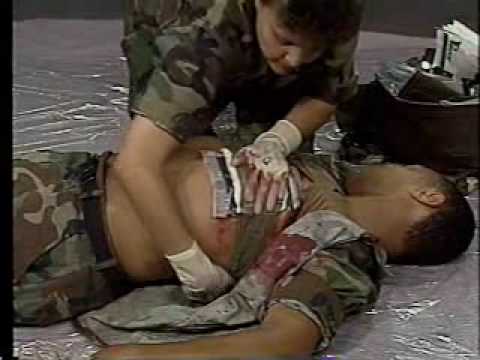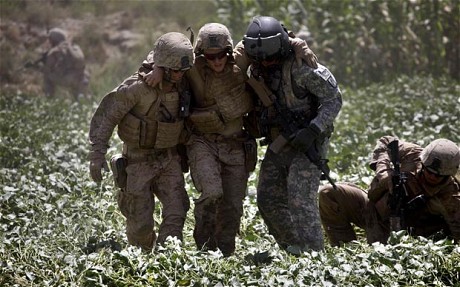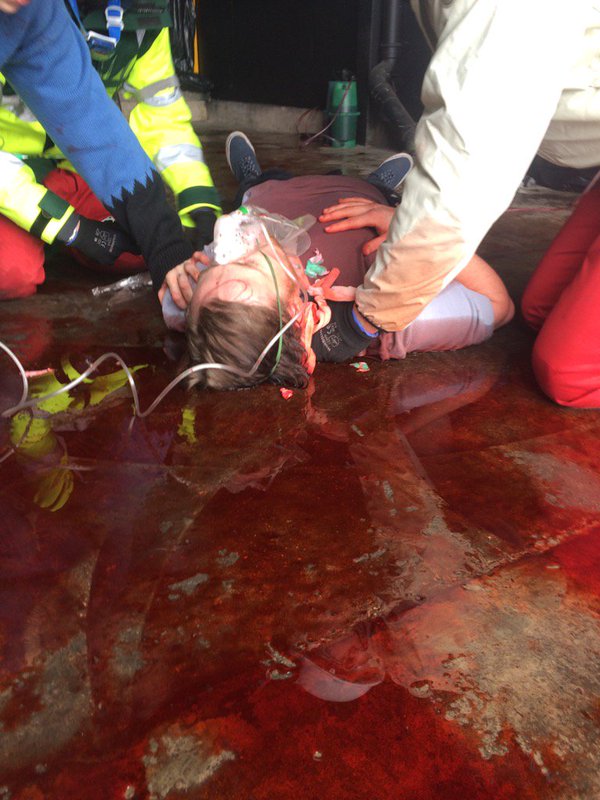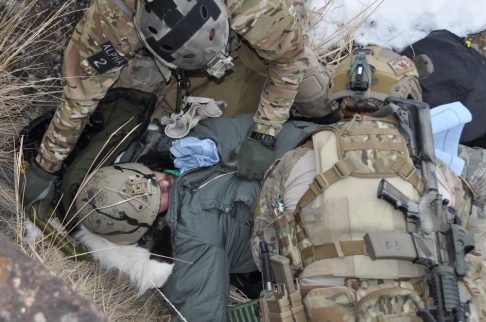By Nils
Let us take a step back and evaluate Tactical Combat Casualty Care (TCCC). This system is developed for the military system and battlefield situations. The police have started to adapt MARCH protocol or the complete MARCHE protocol instead for the classical ABC or the more modern CBA. To know TCCC is not the same as being an EMT specialist or a tactical paramedic, but it is a great beginning. Often we find a TCCC course to include basic gun management and shooting. In TCCC we need to combine two different types of skills to create a combination that might work optimal under given hot operations. This part of First aid is the most stressful that exist and if you aren’t up to it you should step down to normal an EMS practice. To be working in situations that require TCCC is dangerous, and you need to have a proper combat/ survival training in addition to paramedical skills. Never think you know everything, because you will never…

When working with TCCC you automatically switches into MARCH modus and combat like situations. Let us make a short story. It is a shooting and a person gets wounded in the chest. You wait behind the corner until the shooting slows down and at once you crawl to the wounded. Not totally safe, but safer than a few minutes before and no bullets in the air. This is called you enter the zone of CUF – Care under Fire. You find the wounded unconscious with a chest wound that bleeds heavily – a massive haemorrhage and a possible punctured right lung. You evaluate the danger and find that the enemy have moved on. At once you examine the patient deeper and find one entrance – and exit wound, and an another wound on the abdomen connected to the bleeding. In total three holes caused by gun shot. You find it impossible to move the wounded without attending the massive haemorrhage. So you put Celox gauze into the bleeding abdominal wound and put a pressure bandage on top. You wait for about 3 minutes and see that the bleeding is controlled. With that you complete the M in MARCH. Then you pull him with you to a more safe area called the Tactical Field Care (TFC) zone. You evaluate your security in TFC and find it possible to continue the TCCC first aid – MARCH. You continue with letter A. You quickly put a piece plastic over the exit wound and close it completely with tape, and the entrance wound in the same way, but only ¾ closed to create a type of ventilation. The patient starts to get shortness of breath. You suspect that the patient has an accumulation of air in the thorax due to a pneumothorax. You take a G14 needle and puncture the chest of the wounded. You hear a sound of air going out; ssssshhhsss. At once the respiration goes back to situational normal; R- is back to normal. You put a nasopharyngeal (NAP) to secure the flow of air; standard TCCC procedure. The cardiac frequency is situational normal (C – is normal) and you put the clothes back on the wounded to prevent hypothermia (H – is controlled). Then you ask some other soldiers to help you to transport the wounded cack to Tactical Evacuation Care (TACEVAC). There you will observe the wounded until he is transported to the closest hospital.

A tactical paramedic compared to a traditional paramedic is more direct and efficient. Stright to the point, no extras and fooling around. Everything has its distinct place and the procedures are clear in «Tactical Combat Casualty Care Guidelines for Medical Personnell». This is well thought standards for medical care in war zones and safe to follow. Tactical paramedics might choose to adjust their procedure according to situation, but the basic path is in the TCCC guideline. It is advisable to have a tactical first aid kit that includes two chest seals, two packages Celox gauze, a tourniquet, G14 needle for relieving tension pneumothorax, two NPAs, IV equipment with saline, gloves and bandages. This kit need to be assessable and present all the time.

History has shown us that TCCC is just a continuous process of development. Originally TCCC were developed for Special Operations Forces (SOF) in 1996 by Butler and Hagmann focusing on that the preventable causes of death were constant in the recent wars; about 9% of casualties died from extremity wounds, 5% from tension pneumothorax and 1% from airway obstruction. This gave the first indications for an intensive use of tourniquet for bleeding extremity wounds, needle decompression for tension pneumothorax, nasopharyngeal airway placement for airway obstruction, and surgical cricothyrotomy for airway obstruction.

TCCC is tactics mixed with good medicine; first a focus on needed treatment to save life, and second protecting the medical provider against external dangers. This is normally done through trough dividing the work of the tactical paramedic into three phases: Care under fire (CUF), tactical field care (TFC) and tactical evacuation (TACEVAC). During each phase only certain medical treatments and procedures are permitted. Everything calculated based on the danger of the health provider and the wounded. Beside the dangers of bullets it became clear for Butler and Hagmann that SOF works under different conditions than normal EMS and paramedics. In the field it lacks light, it is climate dependent, and many injured, alone, no extra supply, needed with a strict triage and hard decisions. No normal paramedical study might prepare us for this, and therefore we need to study TCCC under these conditions – a tactical paramedic study.

Personally I like to divide into three levels of TCCC practitioners. First we have the normal first aid under combat (stopping haemorrhage, tourniquets, haemostatic dressings and transportation management). Then we have the TCCC trained (like FAC but more advanced, NAP, needle decompression and trained as a helper for the Tactical medical specialist. Tactical medical specialist includes TCCC trained course, the MARCHE protocol (or the MARCH protocol if you prefer) and a lot of tactical training. MARCHE protocol is a protocol to prevent potentially death in war. MARCHE indicates first treatments as massive haemorrhage is treated with pressure, tourniquet and haemostatic agents. Then you solve airway and breathing, put a NAP, if needed a surgical cricothryotomies, needle decompression of tension pneumothoraxes and special dressing on chest wounds. Then go back to C for “circulation” to prevent hypovolemic shock with intravenous fluid administration or intraosseous fluid. Splint fracture, consider the possibility of brain injury and prevent hypothermia. Beside this it is a short pharmaceutical aspect mainly connected to antibiotics for wounds and medicaments for pain relief.

All TCCC interventions have the intention to treat the casualty, prevent further casualties y complete the mission; glued together under the motto: Right medicine at the right time. Remember that TCCC are a military program, and the main goal is to continue the strategic operation. To manage this in the best possible way we divide into three phases of care: Care under fire (CUF), Tactical field care (TFC) and Tactical evacuation care (TACEVAC).
The main goal in TCCC is to provide the best thinkable tactical medicine. The program is under continuous evaluation and adapt to new experiences, – research and – innovations. Most known from this TCCC development is the reintroduction of combat tourniquets (often a Combat Application Tourniquet: CAT) before the onset of shock, and that all soldiers in a combat area carry a CAT ready to use. More advanced tactical paramedics might carry other types of tourniquets, like a junctional tourniquet. Beside this TCCC also have given us a haemostatic agent (gauze and granular). If a wound is out of reach of a tourniquet the tactical paramedics just pack gauze into the wound to still the bleeding. Another important theme is tension pneumothorax and needle decompression; and as TCCC has thought us the needle need to be long and that we need to put the needle decompression laterally in the anterior axillary line. The TCCC theme goes on and on, with changes and adjustments. This is the nature of TCCC.

Remember that TCCC isn’t any standard civilian EMS program. The normal EMS focus is on ABC, spinal immobilization and transport. TCCC focus on security, MARCHE and combat transportation. Just remember that 10% of all injuries occurres when military personnel is treating other wounded soldiers; making fast and direct treatments an important standard. In an armed conflict we find only about 1.5% of all injuries are neck injuries. This creates the fundament of a tactical paramedic; fast in and out, and just a minimum of focus on the cervical area. Spinal immobilization has less importance, and only used if needed. It is of huge importance to move the patient quick to final medical treatment. The introduction of live training on live skin under stress also increased the skill level of the tactical paramedic. We also need to remember that a good first aid kit prepared for TCCC facilitate tactical paramedicine. Accidents will occur and only serious training might prevent human error in combat situations. Research have shown that in about 40%(!) of EMS the paramedic do mistaces due to stress and hesitation. TCCC want to fight these mistakes. Investigations and experiences develop TCCC for the better year by year. Like now, the new is the use of fresh frozen plasma (FFP) on the battlefield, and the haemostatic agents and tourniquets for junctional bleedings. Just remember the basic fact: No matter of what TCCC tells us air goes in and out, and blood goes round and round. If not, fix it!

In classical combat we find one set of injuries that TCCC was constructed around, but today we find a change to a hybrid warfare strategy. This includes a new way of making warfare. Most frequent these days are suicide bombers, terror attacks, drones, biological weapons and insecurity about who is the enemy. Most important is the increase of explosions. Explosions create a mix between spinal injuries AND blunt trauma. We are closing into a paradigmatic change for the traditional TCCC; Battlefield TCCC or Terror act TCCC.
Another important aspect is “Damage control”. This is a term addressing how much damage might a person stand and still complete the mission or to stay alive. Damage control resuscitation (DCR) normally associates with early use of blood product transfusions, less use of crystalloid fluid administration, accept hypotension and immediate haemorrhage control. In other words: Stop haemorrhage, restore the blood volume, and correct coagulopathy (bleeding), acidosis (pH change) and hypothermia (coldness). If you give more than 10 units of red blood cells (RBC)/ 24 hours it is regarded as massive, and the group that receive this amount of RBC is about 8% of the wounded soldiers; the mortality rate in this group is between 27% and 51%. One of the great problems (25%) is coagulopathy; the ability for the blood to clot in impaired – massive haemorrhage. Coagulopathy is normally caused by an intricate mix of these six factors: shock, tissue trauma, acidosis, hemodilution, hypothermia and inflammation. It is recommended to use blood products during resuscitations, but for a tactical paramedic it complicates to transport different blood products. Having written that crystalloid fluid increases the side effects like reperfusion injury, increased leukocyte adhesion and, of course, inflammation, acidosis and multiorgan failure among others. This is why in certain combat groups they preform direct blood transfusion from soldier to soldier after a small field hepatitis and HIV test.
Let us quickly mention the important three aspects: hypothermia, acidosis and Coagulopathy. Hypothermia (less than 34oC) comes from a loss of temperature, loss of blood, use of cold treatment fluids and anaesthesia. Injuries make a person more passive and thereby he creates less heat. A reduced body temperature will create an impeding platelet adhesion (reduced thromboxane production), dysregulates coagulation and interferes with fibrinolysis. The blood need to be 37oC to coagulate properly. Hyperthermia worsens coagulopathy and much more, and that is why body rewarming is that important.
Acidosis occurs when we have an inadequate tissue perfusion. Often we find acidosis when we overuse solution saline in resuscitation. This is due to the concentration of chlorine (154 mEq/L) leading to a hyperchloremic metabolic acidosis. The coagulation depends on the pH, and a lowering of the pH will create a reduced coagulation. A change in pH from 7.4 to 7.0 will create a dramatic change in the coagulation; 90% decrease in factor VIIa and 70% decrease in Xa/Va complex. In short, a transfusion of excessive solution saline might increase the mortality. It exist experiments with bicarbonate and Tris-hydroxymethyl aminomethane – THAM to reduce acidosis, but aggressive blood resuscitation works far better, and THAM works better than bicarbonate.

Coagulopathy (increased bleeding) is a difficult theme due to its complexity. Most frequent we find an increase in coagulopathy due to the administration of intravenous crystalloid. The use of IV correlates with the occurrence of coagulopathy. We know today that 40% of the patients with more than 2 L of IV get coagulopathy, 50% of the people with more than 3 L of IV, and 70% of the patients with more than 4 L of IV. Coagulopathy also occurs in an estimated 1/3 of all trauma patients independent of IV.

The recent years we find something controversial called permissive hypotension enter as one of the important topics within DCR and Damage control. In a way this is to DELAY the initiation of fluid resuscitation and limit the amount of fluids administered. The goal is to maintain a lower blood pressure than normal; 80-90/50 mmHg. This will decrease the coagulopathy, avoid the “pop the clot” effect (when intravascular pressure increases unseal unstable clots) and reduce the inflammatory cascade. Low blood pressure increases the survival rate, and normal pressure will reduce the rate (some investigations tell no difference). It is possible that a prolonged permissive hypotension for more than 2 hours might damage internal organs, but we know that less IV fluid administration will both improve the postoperative survival rate and the 30 days survival rate. In other words, be careful with not overdoing the IV administration in hypovolemic shock patients. It is strong connections to coagulopathy, SIRS (Systemic inflammatory response syndrome), pulmonary oedema and a reduced survival. Having written this, when you give IV administration you need to remember that crystalloids is not the same as colloids (albumin), but the type of fluid does not create that big overall difference and the same mortality (possible it is a little better with crystalloids). Beside the dangers of excessive IV administration of crystalloids we also face the problems of an unbalanced blood transfusion and blood component transfusion might cause more bleeding.

Here is a situation for reflection.



Legg igjen en kommentar